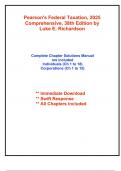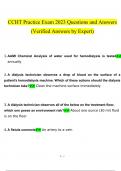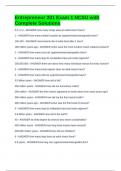Pearson's Federal Taxation, 2025
Comprehensive, 38th Edition by
Luke E. Richardson
Complete Chapter Solutions Manual
are included
Individuals (Ch 1 to 18)
Corporations (Ch 1 to 15)
** Immediate Download
** Swift Response
** All Chapters included
,Table of Contents are given below
INDIVIDUALS
1.An Introduction to Taxation
2.Determination of Tax
3.Gross Income: Inclusions
4.Gross Income: Exclusions
5.Property Transactions: Capital Gains and Losses
6.Deductions and Losses
7.Business Expenses and Deferred Compensation
8.Itemized Deductions
9.Losses and Bad Debts
10.Depreciation, Cost Recovery, Amortization, and Depletion
11.Accounting Periods and Methods
12.Property Transactions: Nontaxable Exchanges
13.Property Transactions: Section 1231 and Recapture
14.Special Tax Computation Methods, Tax Credits, and Payment of Tax
15.Tax Research
16.Corporations
17.Partnerships and S Corporations
18.Taxes and Investment Planning
CORPORATIONS, PARTNERSHIPS, ESTATES & TRUSTS
1.Tax Research
2.Corporate Formations and Capital Structure
3.The Corporate Income Tax
4.Corporate Nonliquidating Distributions
5.Other Corporate Tax Levies
6.Corporate Liquidating Distributions
7.Corporate Acquisitions and Reorganizations
8.Consolidated Tax Returns
9.Partnership Formation and Operation
10.Special Partnership Issues
11.S Corporations
12.The Gift Tax
13.The Estate Tax
14.Income Taxation of Trusts and Estates
15.Administrative Procedures
,Solutions Manual organized in reverse order, with the last chapter
displayed first, to ensure that all chapters are included in this
document. (Complete Chapters included)
Chapter I:18
Taxes and Investment Planning
Discussion Questions
I:18-1 The primary distinguishing feature that causes the Current, Deferred, and Pension Models
to differ is the timing of taxation. With the Current Model, after-tax dollars are invested, and the
investment earnings are taxed currently. With the Deferred Model, after-tax dollars are invested,
but the investment earnings are taxed at the end of the investment horizon. With the Pension
Model, before-tax dollars are invested, and both the contributed dollars and the investment
earnings are taxed at the end of the investment horizon. Thus, the Current Model provides no
deferred taxation, the Deferred Model provides one level of deferred taxation (on earnings), and
the Pension Model provides two levels of deferred taxation (on contributed- dollars and
earnings). pp. I:18-2, I:18-5, and I:18-10 (page numbers where discussion of each model
begins).
I:18-2 The annualized ATROR is the rate of return that would cause an investment conforming
to the Current Model to yield the same accumulation per after-tax dollar invested as the
investment under consideration. It is similar to the internal rate of return of the investment. The
annualized ATROR is useful because it allows the planner to compare various kinds of
investments without knowing the exact amount that he or she will invest. That is, it allows
comparison of rates of returns rather than accumulated dollars. pp. I:18-7 and I:18-8.
I:18-3 First, the BTROR of the capital asset may be lower than the BTROR on a fully-taxable
investment because the capital asset’s return may reflect implicit taxes. Nevertheless, the capital
asset may be preferable because the benefit of deferred taxation will outweigh the reduced rate of
return if the investment horizon is long enough. pp. I:18-8, I:18-24, and I:18-25.
I:18-4 A taxpayer trying to decide between saving outside an IRA or through an IRA should not
necessarily avoid the IRA even if the withdrawal from the IRA would trigger the 10% early
withdrawal penalty. The benefit of deferred taxation of the IRA will outweigh the penalty if the
investment horizon is long enough. On the other hand, a taxpayer who plans to make an early
withdrawal may want to consider the Roth IRA because withdrawals from a Roth IRA are
deemed first from contributions (Chapter I:7). Thus, Roth IRA withdrawals that do not exceed
prior contributions are exempt from taxation and are not subject to the 10% early withdrawal
penalty even though the withdrawals are not qualified distributions. pp. I:18-8 through I:18-14.
I:18-5 It increases over time. Unlike the Current Model, which has a constant annualized
ATROR regardless of the investment horizon, the Deferred Model’s annualized ATROR
increases as the investment horizon increases. That is, rann increases as n increases, assuming a
constant BTROR. This result occurs because the tax deferral benefit increases as the investment
horizon increases. pp. I:18-7 and I:18-8.
Copyright © 2025 Pearson Education, Inc.
I:18-1
, I:18-6 Equivalent if to = tn; not equivalent if to ≠ tn. That is, the Exempt and Pension Models are
equivalent if the tax rate in the contribution year equals the tax rate in the withdrawal year and
the contribution to each (in BT$) is the same. The equivalence breaks down, however, when to
and tn are not equal. Assuming constant BTRORs, the Exempt Model is better than the Pension
Model if tax rates are increasing (i.e., to < tn). Conversely, the Pension Model is better than the
Exempt Model if tax rates are decreasing (i.e., to > tn). The $7,000 limitation (for 2024) affects
the comparison of a traditional deductible IRA (Pension Model) and a Roth IRA (Exempt
Model) because the $7,000 maximum contribution to a deductible IRA is deductible (BT$) while
the $7,000 maximum contribution to a Roth is not deductible (AT$). To properly compare these
two vehicles, the analyst must determine the after-tax accumulation resulting from investing the
tax savings from the deductible contribution. This amount must be added to the deductible IRA
accumulation so that the total accumulation can be compared with the accumulation from the
Roth IRA. pp. I:18-12 through I:18-14.
I:18-7 Deferral of shareholder tax. The C corporation entails two levels of taxation, one at the
corporate level and another at the shareholder level. Assuming no current distributions (i.e.,
dividends), the shareholder’s tax is deferred until the shareholder sells the stock or until the
corporation liquidates. This deferred taxation is captured in the Deferred Model. pp. I:18-21 and
I:18-22.
I:18-8 The key factor in the Roth conversion decision is the tax rate structure. A low tax rate at
the time of conversion compared to a high tax rate at the time of withdrawal would bias the
decision toward converting to the Roth. In this case, the conversion tax would be at a relatively
low tax rate while distributions from the Roth IRA would avoid being taxed at a high tax rate.
Other factors also come into play, such as rates of return and the source of paying the conversion
tax, but the tax rate structure is the key component of the decision. p. I:18-19.
I:18-9 The tax rates facing individual entity owners versus the 21% C corporation tax rate are key
factors. Also important is the qualified business income (QBI) deduction available to pass-through
entity owners. The QBI deduction effectively reduces the owner’s tax rate by a factor of 20%. The
100% Sec. 1202 exclusion, if applicable, plays an important role as well because it reduces the C
corporation shareholder’s tax rate to zero upon the sale of the corporate stock. pp. I:18-22 through
I:18-24.
I:18-10 Implicit taxes. An investment conforming to the Exempt Model may have a lower
BTROR than does a risk-equivalent investment conforming to the Current Model because of
implicit taxes. See the solution for Discussion Question I:18-11 for a discussion of the process that
leads to implicit taxes. pp. I:18-24 through I:18-27.
I:18-11 An implicit tax is the reduced BTROR on a tax-favored investment compared to the
BTROR on a risk-equivalent fully taxable benchmark investment. The implicit tax is defined as
IT = Rb - Re, where Rb is the BTROR on the benchmark investment, and R e is the BTROR on
the tax-favored investment. Investor demand for the tax-favored investment will drive up its
price and drive down its BTROR until ATRORs are equal for the marginal investors. This
reduced BTROR is an implicit tax. pp. I:18-24 through I:18-27.
Copyright © 2025 Pearson Education, Inc.
I:18-2






